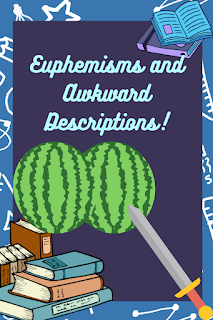Euphemisms and Awkward Descriptions
There is such a thing as being too creative when it comes to
writing. This is especially apparent when we’re discussing romantic scenes. The
descriptors some authors choose for body parts can be questionable.
I adore the videos from Atomic Apple Pie where she reads out
some of these descriptions and how cringe they are. It’s entertaining but also
kind of bizarre. Sometimes you can overdo it.
For example, it seems to be common for the male organ to be
compared to a weapon: a spear, a sword, love’s sweet arrow. Weapons imply
violence, and that isn’t really a good thing. So maybe let’s not. This often
goes along with describing the female genitalia as a ‘sheath’ for said ‘sword’
which again feels a bit weird. Also, ‘impaling’ to describe the act of
penetration has similiarly violent connotations.
Talking about the vagina as a ‘woman’s secret place’ or a ‘cave’
is weird to me as well. Like, it’s not that complicated or secretive. It’s not
like most women hide their treasures in there like a dragon’s hoard. ‘Lady
garden’ and ‘flower’ are polite I guess but again it’s just a bit of an odd
comparison.
I also loathe the descriptions using ‘moist’ and ‘damp’, a
lot of people get the ick from the word ‘moist’ and dampness sounds unpleasant.
Like a leaky basement or something, where you’d see mould growing. Not sexy to
most people, is it?
Food is another common comparison. Sausages and ham sandwiches,
or beef anything is just strange and off-putting for me. Keep your ‘man meat’
to yourself, please. Same goes for breasts: melons, citrus fruits or pancakes –
none of that sounds sexy to me.
Of course using juvenile words like ‘peepee’ and ‘hooha’
should also be avoided. You’re writing adult fiction for adults, so let’s
behave like adults, yes? Using such childish words gives it a creepy vibe.
I understand that using the correct anatomical terms can
sound very clinical and make you feel like you’re back in biology class. I’m
reminded of that scene in Friends where Ross is asked to talk dirty to a woman
he’s dating and he says ‘vulva’. It’s the correct word for the external
genitalia, but it doesn’t sound that appealing.
So my advice is to keep it relatively simple, pick a couple
of commonly used terms that fit the vibe of your story and stick with those.
Think about what words are used in sex scenes you enjoyed reading and echo
those. If you can’t read it out loud without cringing, it needs revision.
Another point is that romance scenes work a lot better if
your focus is on the emotions and the relationship between the characters
instead of detailed stage directions of what is happening. Tab A goes into slot
B, that kind of thing. Like with fighting and action scenes, it’s not just
about what the characters are doing, but how the action affects the characters
and their relationships with each other.
Emi the Cat Lady 💜








